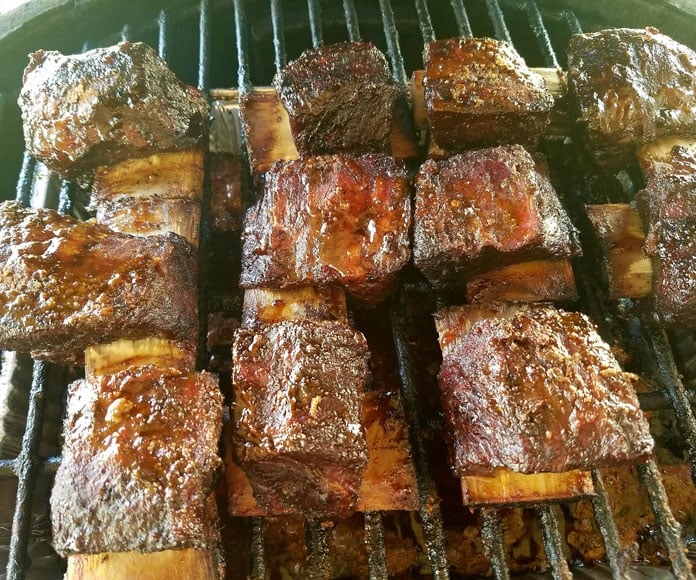Fired Up Fridays: Ribs in the Garden of Eaten
A weekly barbecue blog for the summer.

Scott Schumaker is president of PacificBasin and interim publisher of Hawaii Home + Remodeling. He is also an avid barbecuer, who often tempts co-workers by posting images of his culinary feats on his Instagram, @schuboxphoto. We convinced him to share his secrets each week this summer with our readers in our Fired Up Friday blog. His grill smoker of choice is a Big Green Egg he purchased from POP Marine and Fishing. He also uses a Weber Summit gas grill, especially for rotisserie cooking, which he got at AirGas Gaspro Kapolei.
Somebody knew what they were doing when they grabbed Adam’s rib to create Eve. When it comes to mammalian body parts being used to create objects of beauty, every backyard barbecue enthusiast knows ribs smoked right are a biblical experience. Whether they are beef or pork, St. Louis-style spares or baby backs, ribs are the holy grail of the meat-smoking world. Smoking them right is as easy as 3-2-1.
The Prep
The day before you smoke the ribs, give them a good rubdown with your favorite spice mix.
For pork ribs, first remove the silver membrane from the back of the rack. Insert a butter knife between a bone in the middle of the rack and the membrane. Work the knife down along the bone to lift the membrane. When you have lifted it enough, insert your finger and give the membrane a good pull. It should pull right off. It is important to remove this as it would otherwise cook up very tough, preventing the rub from getting into the meat. We don’t want tough, tasteless ribs.
Once the membrane is removed, lightly coat the back of the ribs with yellow mustard. The mustard will not impart much flavor, but it will help the rub adhere to the meat. If you don’t have mustard, olive oil will do. Firmly rub the spice mix into the meat.
Turn the rack over, brush on mustard and firmly rub the spice mix into the meaty side of the rib. At this stage, I cut the racks in half, making them easier to handle during the cook. Plus, I don’t have to worry as much that the end ribs might get overcooked during their six hours on the smoke.
Return the ribs to the fridge to marinate overnight.
For beef short ribs, we essentially do the same thing — but don’t remove the back membrane. I find olive oil works better than mustard for a sticking agent. Make sure all the sides and ends of the meat are coated with rub.
The Cook
We will be using the 3-2-1 method to smoke the meat, both the beef short ribs and the St. Louis-style pork spareribs. That’s three hours uncovered, two hours wrapped and braised and the last hour uncovered again, sauced and glazed.
First, set your smoker or grill for an indirect cook and bring the temperature to a stable 225-250 degrees. I use a Weber iGrill2 to help measure my smoker’s cooking temperature. I set a water pan in the smoker as well with a 50/50 mix of apple juice and apple cider vinegar. This keeps the smoker — and ribs — moist throughout the cook and the apple juice in the steam imparts some flavor as well. I use one fist-sized chunk of both apple and cherry wood for the smoke.
In the first phase, smoke the ribs for three hours. If you’d like, you can spritz the ribs every 30 minutes or so with the apple juice/cider mix.
After those three hours are pau, it’s time to braise the ribs for two hours. You can either wrap them in heavy-duty aluminum foil with a small amount of apple juice, coffee, cola, etc. Or, place them in an aluminum pan with the braising liquid and seal it tightly with foil. Here, I use the pan method with coffee and dark beer as my braising liquid for the beef short ribs. I decided not to wrap the pork ribs and just left them uncovered. That’s OK to. It really depends on how firm you like your ribs. If you want softer, fall off the bone ribs, then wrap ‘em.
After braising for two hours, unwrap or remove the ribs from the pan and place them back on the smoke. Now it’s time to sauce them, but only if you want them wet; if you prefer dry ribs, skip this step. For wet, lightly sauce both sides of the rack and flip it every 20 minutes or so as the sauce cooks to a glaze.
So, after six hours, are they done? Since barbecuing is not an exact science, they might be. And they might not be. How can you tell? One way is to make sure the meat has sufficiently receded from each end of the bone. Or for pork ribs, pick up the rack in the middle with tongs in the middle and see if it bends enough at each end. If it stays stiffly straight out, keep smoking them. Of course, the best way is to cut one off and give it a try.
When the ribs pass the taste test, if there are any left, slice and serve them to the family. While handing the ribs to your wife, it’s a good idea to remind her that although she stole one of your ribs in biblical times, you don’t mind giving her more now because baby’s got rack.






